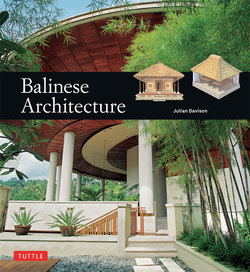Читать книгу Balinese Architecture - Julian Davison - Страница 11
На сайте Литреса книга снята с продажи.
ОглавлениеThe Dwelling Compound
The Balinese residential compound is home to an extended family typically consisting of a married couple, their married sons with their wives and children, their unmarried daughters, and, if they are still alive, the parents of the husband. If a group of brothers decides to stay together, each brother will have his own living quarters within the compound with its own kitchen facilities.
A family shrine dedicated to the ancestral spirits.
Entrances
Balinese compounds have only one entrance, on the side bordering the street. Entrances define the threshold between inside and out and are viewed ambivalently; although they may admit welcome visitors they may also allow in malign influences. Thus, the entrance belongs to the vile sphere and should therefore be located at the compound’s kelod end, and to the west. A small wall (a!ing-a!ing) is often placed directly behind the doorway. This screens off the interior, but more importantly obstructs the entry of malevolent spirits, which are believed to have difficulty making abrupt changes of direction.
The level inside the compound is generally a little higher than that of the street outside. This serves both a practical and symbolic function. On the one hand, it makes it easier to provide drainage for the compound simply by creating conduits that empty into a ditch running on either side of the road. On the other hand, the superior elevation is part of a hierarchical ordering of space that runs from the street to the family temple (sanggah) situated in the kaja-kangin corner of the compound. The family temple is the highest point in the compound, reflecting its status as sacred ground.
The Family Temple
The family temple is set off from the rest of the buildings in the compound by a low wall which provides a sacred enclosure (pamerajan) for the family shrines. The relative dimensions of this walled-off space are governed by ritual prescriptions similar to those that regulate the shape and size of the compound as a whole. Different dimensions have different implications. For example, the gods are said to favor a family whose sanggah enclosure is only one unit longer than it is wide; even higher esteem is attached to those whose place of worship differs by two units, and great purity where the difference is one of five units. These attributions are not always positive: marriage to an unfaithful wife may be the fate of those where the difference between length and width is eight units. The location of the entrance to the sanggah enclosure is also important and should ideally be placed between the sleeping pavilion (umah meten) of the family head and the bale kangin, the pavilion occupying the eastern side of the central court. A north-facing entrance is considered to be particularly inauspicious.
Gods and Ancestors
The family temple contains a number of different shrines dedicated to both the gods and to family ancestors. The most prominent of the shrines is the sanggah kamulan, a small, wooden, house-like construction raised on pillars and standing on a sandstone or brick column. This structure is divided into three compartments, dedicated to the Hindu triumvirate (trimurti) of Brahma, Siwa, and Wisnu. Brahma is associated with the male ancestors of the household, while Wisnu is identified with the female ancestors. A Balinese man should build one of these shrines when he marries.
The sanggah kamulan stands in the kaja-kangin corner of the temple enclosure, together with other ritual structures dedicated to Mother Earth (Ibu Pretiwi) and to the sacred mountains of the island, Gunung Agung and Gunung Batur. The rice goddess, Sri, shares a shrine (panegtegan) with the deities of wealth and knowledge, Rambut Sedana and Saraswati, respectively. There may also be an altar dedicated to the sun god, Surya.
Other ritual structures can also be located in the kaja-kangin corner of the temple enclosure, dedicated to one or more of several different gods and goddesses. These structures vary according to the status of the head of the family but are often simple, thatch-roofed structures. There will also be a number of brick and sandstone columns around the compound where offerings can be placed for the spirits who guard the home and its occupants.
Sleeping, Eating, and Bathing
The Balinese compound appears to lack what Western visitors would recognize as adequate provision for sleeping, eating, and bathing. The head of the family sleeps in the most prestigious pavilion in the compound, the umah meten, which he inherits from his parents when they die, situated along the kaja wall of the central courtyard. Children and their mothers tend to sleep in the bale sakepat, but other family members sleep wherever they choose—typically in one of the open-sided pavilions around the central courtyard (natar) or the platform beneath the rice granary. There are seldom any bathing facilities within the compound, though piped water has altered the situation in recent years, and people take their bath in rivers, water conduits and specially constructed bathing pools.
The salients at the four corners of the compound are intended to impede bad feelings arising within the compound from being broadcast abroad and, conversely, to prevent malign influences from entering from outside. These bastions against the passage of malevolency in and out of the compound are called paduraksa. Padu means “corner” and raksa means “guardian.”
Layout of a Residential Compound
1 Entrance.
2 Aling-aling, or “blind” wall.
3 Natar or latar, a level, open yard in the center of the compound, which is kept free of built structures.
4 Sanggah, or family temple.
5 Umah meten, a sleeping pavilion for the head of the family.
6 Bale tiang sanga, a pavilion for receiving guests.
7 Bale sakepat, a pavilion where children and other junior members of the family sleep.
8 Bale sakenam, traditionally a place where women do their weaving.
